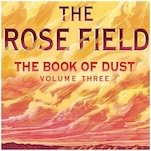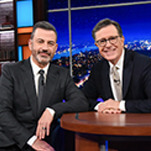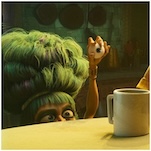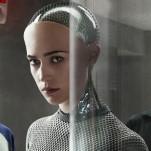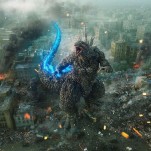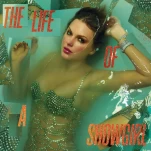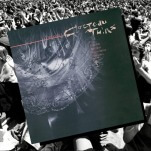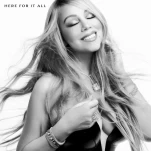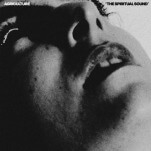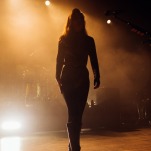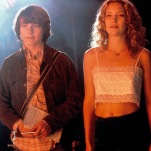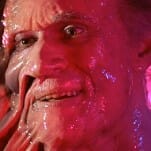The 50 Best Horror Movies on Tubi Right Now (October 2025)

Diving headfirst into the horror library of Tubi is a dizzying, potentially nauseating experience, not just for the gory horror films you’ll find there, but for the sheer haphazardness of the journey. As a free, ad-supported streaming service, Tubi horror has one major thing going for it: Pure scale. Their horror library is utterly massive, with close to 1,000 films available, but the functionality and ability to browse those films in a logical way is practically nonexistent. It’s a library that eclipses other streamers—much bigger than Netflix, and bigger even than the likes of a genre-specific streamer like Shudder. But man, what a clumsy UI.
You’ll notice this as soon as you tell Tubi to show you the results of a particular genre. Choose “horror movies,” and there’s no way to further refine that selection of almost 1,000 films, with names like The Unhealer and Bone Face. You can’t reorder the list alphabetically. There are no subgenres, or further categories. Dubs and different language cuts of the same film appear multiple times throughout the list, nowhere near each other. It appears to have been arranged in completely random order.
That’s why our guide to the best Tubi horror movies is so important—do you really want to scroll through 1,000 movies looking for something to watch? Or do you want to go straight to the cream of the crop? Check out our picks for some Tubi horror hidden gems below, and then check out our lists of the best horror content available on a bevy of other streamers.
You may also want to consult the following horror-centric lists:
The 100 best horror films of all time.
The 100 best vampire movies of all time.
The 50 best zombie movies of all time.
The 50 best movies about serial killers.
The 50 best slasher movies of all time
The 50 best ghost movies of all time.
The best horror movies streaming on Netflix.
The best horror movies streaming on Amazon Prime.
The best horror movies streaming on Hulu.
The best horror movies streaming on Shudder.
The 50 Best Tubi Horror Movies
1. The Changeling
Year: 1980
Director: Peter Medak
Stars: George C. Scott, Trish Van Devere, Melvyn Douglas, John Colicos
Rating: R
George C. Scott tempers his natural irascibility to play a melancholy composer grieving for his recently deceased wife and daughter in Peter Medak’s conflation of haunted house movie and supernatural whodunit. Dubbed one of the scariest movies of all time by Martin Scorsese, The Changeling deals the terror out in spades, with Medak playing up the tightening fear of the unknown with the precision of a horror maestro. (Indeed, it’s amazing Medak had never even been near the genre before.) Having moved into a new home, a century-old manor also occupied by the restless spirit of a young boy, Scott’s John Russell digs to discover the tale of an institutional cover-up, and of power wielded monstrously in the name of financial gain. The Changeling may be a showcase for an effortlessly magnetic veteran lead, but it’s also a mystery thriller that engrosses as it frightens. What begins as another haunted house story ends as a commentary on the history of America: a nation built not just on hard work, but also on blood and not-always-heroic sacrifice. —Brogan Morris
2. The Texas Chain Saw Massacre
Year: 1974
Director: Tobe Hooper
Stars: Marilyn Burns, Paul A. Partain, Edwin Neal, Jim Siedow, Gunnar Hansen
Rating: R
One of the most brutal mainstream horror films ever released, The Texas Chain Saw Massacre, based on notorious Wisconsin serial killer Ed Gein, resembles art-house verité built on the grainy physicality of its flat Texas setting. Plus, it introduced the superlatively sinister Leatherface, the iconic chainsaw-wielding giant of a man who wears a mask made of human skin, whose freakish sadism is upstaged only by the introduction of his cannibalistic family with whom he resides in a dilapidated house in the middle of the Texas wilderness, together chowing on the meat Leatherface and his brothers harvest, while Grandpa drinks blood and fashions furniture from victims’ bones. Still, The Texas Chain Saw Massacre might not be the goriest horror film ever made, but as an imaginal excavation of the subterranean anxieties of a post-Vietnam rural American populace, it’s pretty much unparalleled. Twisted, dark and beautiful all at once, it careens through a wide variety of tones and techniques without ever losing its singular intensity. (And there are few scenes in this era of horror with more disturbing sound design than the bit where Leatherface ambushes a guy with a single dull hammer strike to the head before slamming the metal door shut behind him.) —Rachel Haas and Brent Ables
3. Day of the Dead
Year: 1985
Director: George A. Romero
Stars: Lordi Cardille, Terry Alexander, Joe Pilato, Richard Liberty
Rating: R
Although Dawn will probably always have more esteem, and is significantly more culturally important, Day of the Dead is my personal favorite of George Romero’s zombie films, and I don’t think it ever quite gets the respect it deserves. It comes along at a sort of sweet spot—bigger budget, more ambitious ideas and Tom Savini at the zenith of his powers as a practical effects artist. The human characters this time are scientists and military living in an underground bunker, which for the first time in the series gives us a wider view of what’s been going on since the dead rose. This film reintroduces the science back into zombie flicks, finally making one of the main characters a researcher (Matthew “Frankenstein” Logan) who has had some time to study the zombies in the relative safety of a lab. As such, the movie redefines the attributes of the classic Romero ghoul—they’re dumb, but not entirely unintelligent, and some of them can even be trained to use tools and possibly remember certain aspects of their previous lives. That of course brings us to “Bub,” maybe the single most iconic zombie in Romero’s oeuvre, who displays a unique level of personality and even humor. Day of the Dead ultimately takes a monster that audiences thought they knew pretty well at this point and suggests that perhaps they were only just scratching the surface of zombies’ potential. —Jim Vorel
4. The Wailing
Year: 2016
Director: Na Hong-jin
Stars: Kwak Do-won, Hwang Jung-min, Chun Woo-hee
Rating: NR
The U.S. title of Na Hong-jin’s new film, The Wailing, suggests tone more than it does sound. There is wailing to be heard here, yes, and plenty of it, but in two words Na coyly predicts his audience’s reaction to the movie’s grim tableaus of a county in spiritual strife. Na trades in doubt and especially despair more than in what we think of as “horror.” He isn’t out to terrify us. He’s out to corrode our souls, much in the same way that his protagonist’s faith is corroded after being subject to both divine and infernal tests over the course of the film. The Wailing unfolds in Gokseong County, an agricultural community nestled among South Korea’s southern provinces. It’s a lovely, bucolic setting that Na and his cinematographer, the incredible Hong Kyung-pyo, take fullest advantage of aesthetically and thematically. The hushed serenity blanketing The Wailing’s opening images creates an atmosphere of peace that Na is all too happy to subvert (similar to how he subverts Bible verses). The film’s first full sequence shatters the calm as Sergeant Jeon Jong-gu (Kwak Do-won, turning in a knockout performance) is called to the scene of a savage multiple murder. When Jong-gu shows up, all is bedlam; people are screaming and crying, emergency workers litter the area like ants at a gory picnic, and the killer sits in a stupor, unaware of neither the mayhem nor the vicious boils coating their skin. This is an incredibly creepy and oft-unsettling film, but Na finds the tug of disbelief far more upsetting than the sight of bodies cut apart and blood splattering the wall. What do you do when your holy authority figures fail you? What do you do when you can’t trust your perception? Na has made these ideas, though hardly new in the horror canon, his film’s full purpose, and his conclusions are devastatingly bleak. When The Wailing arrives at its final, spectacular half hour, you’ll vow never to ask these questions about your own life, ever. You may not leave the theater scared, but you will leave it scarred, which is by far a more substantive response than naked fear. —Andy Crump
5. The Babadook
Year: 2014
Director: Jennifer Kent
Stars: Essie Davis, Noah Wiseman
Rating: NR
Classifying Jennifer Kent’s feature debut, The Babadook, is tricky. Ostensibly this is a horror film—freaky stuff happens on an escalating scale, so qualifying Kent’s tale of a single mother’s fractious relationship with her young son with genre tags seems like a perfectly logical move. But The Babadook is so layered, so complex and just so goddamned dramatic that categorizing it outright feels reductive to the point of insult. There’s a grand divide between what Kent has done here and what most of us consider horror. You’ll spend your first week after the experience sleeping with the lights on. You will also come away enriched and provoked. Australian actress-turned-filmmaker Kent has made a movie about childhood, about adulthood and about the nagging fears that hound us from one period to the next. There’s a monster in the closet—and under the bed, and in the armoire, and in the basement—but the film’s human concerns are emotional in nature. They’re not aided by the ephemeral evil lurking in the dark places of its characters’ hearts, of course; going through personal trauma is enough of a chore when you’re not being stalked by the bogeyman. —Andy Crump
6. The Invitation
Year: 2016
Director: Karyn Kusama
Stars: Logan Marshall-Green, Tammy Blanchard, Michiel Huisman, Emayatzy Corinealdi, John Carroll Lynch
Rating: N/A
The less you know about Karyn Kusama’s The Invitation, the better. This is true of slow-burn cinema of any stripe, but Kusama slow-burns to perfection. The key, it seems, to successful slow-burning in narrative fiction is the narrative rather than the actual slow-burn. In the case of The Invitation, that involves a tale of deep and intimate heartache, the kind that none of us hopes to ever have to endure in our own lives. The film taps into a nightmare vein of real-life dread, of loss so profound and pervasive that it fundamentally changes who you are as a human being. That’s where we begin: with an examination of grief. It’s remarkable for its foundation, for all of the substantive storytelling infrastructure that Kusama builds the film upon in the first place. The film starts in earnest as Will (Logan Marshall-Green in top form) arrives at a dinner party his ex-wife, Eden (Tammy Blanchard), is throwing at what once was their house. He has brought his girlfriend, Kira (Emayatzy Corinealdi), along with him. But something is undeniably off at Eden’s place, and because Will is the lens through which Kusama’s audience engages with the film, we cannot tell what that something is. There is oh so much more to be said about The Invitation, especially its climax, where all is revealed and we see Will’s fears and Eden’s spiritual affirmations for what they are. Until then you’ll remain on tenterhooks, but to Kusama, jitters and thrills are sensations worth savoring. Where we end is obviously best left unsaid, but The Invitation is remarkable neither for its ending nor for the direction we take to arrive at its ending. Instead, it is remarkable for its foundation, for all of the substantive storytelling infrastructure that Kusama builds the film upon in the first place. —Andy Crump
7. Let Me In
Year: 2010
Director: Matt Reeves
Stars: Kodi Smit-McPhee, Chloe Grace Moretz, Elias Koteas, Richard Jenkins
Rating: R
Practically more supernatural a creature than its starring monster, Let Me In is not only an Americanized adaptation of a foreign film that isn’t a waste of everyone’s time, it’s arguably superior than the film it’s based upon. Like the original Swedish film, Let the Right One In, Matt Reeves’ update teases a remarkable amount of tension and intrigue through meticulous plotting and arresting imagery. Though set in Los Alamos, New Mexico, rather than Stockholm, the choice of place for relocation initially seems an odd one—but it turns out it’s not the icy Swedish darkness that harbors the sense of unease. It’s the isolation of a 12-year-old boy, neglected by parents and any real parental figure. Owen’s (Kodi Smit-McPhee) bond with the eternally youthful vampire Abby (Chloë Grace Moretz) is as effective and chilling here as it is in the original, thanks in no small part to its two phenomenal young leads. No question there’s a modern horror classic here, from the unlikeliest of origins. —Scott Wold
8. Possessor
Year: 2020
Director: Brandon Cronenberg
Stars: Andrea Riseborough, Christopher Abbott, Sean Bean, Jennifer Jason Leigh
Rating: R
The barren, lonely, modest urban landscapes of Brandon Cronenberg’s Possessor reflect a familiar perspective. Brandon is, as you either already know or have surely guessed, David’s son; he shares his father’s interest in corporeal grotesquery, physical transformation representing mental transformation, and an unnerving, topical preoccupation with viruses. Brandon cuts deeper than daddy, though, if not (yet) with the same incisiveness, then with a clinical precision that only intensifies the oneiric oddness coursing intractably through Possessor. This disturbing horror/thriller follows Tasya (Andrea Riseborough), an assassin working for a shady organization that carries out its hits via remote cerebral link between assassin and unwitting host—in this case Colin (Christopher Abbott). Cronenberg charts a horrific journey from mind to mind, plotted along neural pathways but predictably expressed along physical routes. It veers off into an arterial journey, the narrow vessels containing the stuff of life—and death—in a larger body. The film has the feel of a grand sci-fi spectacle shrunk down to a dark, dingy miniature; its crude efficiency belies the potency of Cronenberg’s ruminations on the theme of a foreign invader corrupting a wayward soul in a poisonous society.–Paddy Mulholland
9. Goodnight Mommy
Year: 2014
Directors: Veronika Franz, Severin Fiala
Stars: Susanne Wuest, Elias Schwartz, Lukas Schwartz
Rating: R
We begin by joining twin, tow-headed nine-year-old brothers Lukas (Lukas Schwarz) and Elias (Elias Schwarz) as they explore the rural paradise of their new home, swimming in azure-pure lakes and casually spelunking through nearby caves ostensibly untouched for centuries. Though the twins seem to be perfectly content letting their Edenic nature occupy them, a near-ineffable pall of tragedy hangs over the film from the start. It’s unexplainable but slightly pungent, as if at any moment one of the boys will fall down a ravine or stumble into a hornet’s nest. Maybe it’s because they bow to seemingly no adult supervision—that is, until their mother (Susanne Wuest) returns to their ceaselessly modern home after going away for a surgery of some sort. Her face covered in bandages, her eyes red-rimmed and limned with a shadow of dread, “Mommy” greets her boys with reticence and anxiety. Gradually, of course, the boys suspect that something is up with their mommy, especially when, as a form of punishment for their suspicious behavior (as well as, we assume, behavior and transgressions we have yet to understand), she pretends that Lukas doesn’t exist. Goodnight Mommy, for all of its familiar notions, isn’t exactly a traditional horror film, more in tune with the eerie, silent moral plays of Carl Theodor Dreyer than with the Grand Guignol schlock of an Eli Roth in heat. In fact, you may be able to figure out the “twist” by the end of the first act; while the filmmakers do nothing to bury the lede, they still take great pains to juggle their high-minded concept with an eye for burrowing certain notions about the very fabric of our human race within the subcutaneous folds of our most firmly held beliefs about how life—family, love, trust—should work. The true horror of Goodnight Mommy isn’t about who she is, but what happens to her—how easily we can set fire to the bedrock of even our basest notions of what it means to be human. And there really is nothing scarier than that. —Dom Sinacola
10. The House of the Devil
Year: 2009
Director: Ti West
Stars: Jocelin Donahue, Tom Noonan, Mary Woronov, Greta Gerwig, A.J. Bowen, Dee Wallace
Rating: R
Detractors complain that Ti West’s movies are “slow,” which is missing the point. A better adjective is “deliberate.” On The House of the Devil, the first film to really start giving him a reputation as a director to watch, West builds the tension gradually and carefully, as though there is nothing scarier than watching a young woman dance around an empty house while listening to the Fixx. By the time the second act ends, you’ve been holding your breath for an hour when the film explodes into its gory, violent third act, which offers a perverse sense of release. It also gives Jocelin Donahue’s heroine her finest moment, as she at least attempts what the audience is by then shouting for her to do. It’s another film where the low-budget look perfectly fits the aesthetic, mirroring the style of “old dark house” and Satanist films that West is clearly drawing on as inspiration. —Stephen M. Deusner
11. We Need to Talk About Kevin
Year: 2017
Director: Lynne Ramsay
Stars: Tilda Swinton, John C. Reilly, Ezra Miller
Rating: R
A pitch-black drama from writer/director Lynne Ramsay, We Need to Talk About Kevin is a fascinating study of a sociopath, a family, and the former’s effect on the latter. While it allows Ezra Miller to showcase his alienesque abilities as a problem child, the film’s richest element is the evolving relationship between his parents (John C. Reilly and Tilda Swinton). Reilly and Swinton construct a fractured window into a marriage, with one (possibly evil) rock thrown square through it. Gripping and disturbing, Ramsay’s effort (co-written by Rory Stewart Kinnear) strikes at a vague yet central parental fear through its horrifying specificity: what happens if I screw this up? —Jacob Oller
12. The Autopsy of Jane Doe
Year: 2016
Director: André Øvredal
Stars: Emile Hirsch, Brian Cox, Olwen Catherine Kelly
Rating: R
Men don’t understand women. It’s the oldest cliché in comedy, in psychology, in nearly every book Dave Barry has ever written, in men’s and women’s health magazines alike. In André Øvredal’s The Autopsy of Jane Doe, the cliché is no less clichéd, but he does appropriate it for use in a powerful metaphor for male blindness to female traumas: The film is about a woman’s invisible suffering, the kind experienced beneath her exterior and which men can neither see nor comprehend, even when they have the benefit of being able to literally peel back her layers. You can probably guess from the title exactly what layers are being peeled, which is to say that you’ll know right off the bat whether The Autopsy of Jane Doe is for you or not. What you won’t discover without watching the film is the source of Jane’s anguish, though by the time Øvredal is done with us, you may wish you’d never looked close enough to learn for yourself. —Andy Crump
13. Tenebrae
Year: 1982
Director: Dario Argento
Stars: Anthony Franciosa, Christian Borromeo, Mirella D’Angelo, Veronica Lario, Ania Pieroni
Rating: R
For Tenebre, a film about a killer inspired by the gruesome violence of a horror author’s body of work, Dario Argento turned the gun (or, the gleaming blade in a gloved hand) on himself. Using dramatic mirrors and misdirects, Tenebre tells an unhinged and volatile story about violence being let loose on the world, about how human beings are channels for murder. Here, Argento levels up the impact and tenacity of his craft, matching the screaming pitch of his themes with panic-inducing stalker sequences and some pretty gnarly violence. In copping to the criticisms of his work, Argento points the finger at all those indulging in what he has to offer, and despite some messiness getting there, Tenebre delivers one of the most breathtaking climaxes in his career.
14. Starry Eyes
Year: 2014
Director: Kevin Kölsch
Stars: Alexandra Essoe, Amanda Fuller, Noah Segan
Rating: N/A
Starry Eyes is a harrowing film experience, an ordeal, in the same way its protagonist’s journey is a major transformation. At the beginning, you think you have a pretty decent idea of the surface-level points Starry Eyes is trying to make; you get its “Hollywood against Hollywood” bitterness and cynicism about fame and the film industry’s pettiness. Then everything gets so much more destructive and subversive. Sarah (Alex Essoe) is a tragic figure, and this is a “horror tragedy,” if such a thing exists, made worse by the fact that she brings it all onto herself, fueled by deep-seated inadequacy and a crushing lack of self-identity. Her ambition turns her into a monster because she has nothing else: Her life is so devoid of meaning that doing the unthinkable has no downside. Hers, then, is a horrific self-destruction that leads into an abandonment of self and an orgy of truly grotesque violence, but there’s no joy or titillation in any of the ways it’s depicted. No one is going to describe Starry Eyes as light viewing, and no one is going to laugh at the deaths. You don’t show this thing at a party—you dwell on it in the depth of night while self-identifying with its horrors. —Jim Vorel
15. Hellraiser
Year: 1987
Director: Clive Barker
Stars: Andrew Robinson, Clare Higgins, Ashley Laurence
Rating: R
The head villain/eventual hero (there’s a sickening number of terrible Hellraiser sequels) behind Clive Barker’s Hellraiser franchise is the Cenobite Pinhead, sent from the pits of his own personal hell dimension to drag you down into the depths with him. Where he tortures you. For eternity. All because you opened a fancy Rubik’s Cube. Pinhead has zero remorse, looking you dead in the eye as he delivers a deadpan promise to “tear your soul apart.” Oh yeah, and the Cenobites are indestructible. Personally, it turned me off to puzzle boxes forever. As in his fiction, Barker’s obsessions with the duality of pain and pleasure are on full display in Hellraiser, an icky story of sick hate and sicker love. —Rachel Haas
16. The Cabin in the Woods
Year: 2011
Director: Drew Goddard
Stars: Kristen Connolly, Chris Hemsworth, Anna Hutchison, Fran Kranz, Jesse Williams, Richard Jenkins, Bradley Whitford, Sigourney Weaver
Rating: R
The gag here is that a group of young people—who loosely fall into a variety of slasher movie archetypes such as “the virgin,” “the fool” and “the athlete,”—are manipulated into a life-or-death scenario that also serves as a proxy battle for all of humanity. This “ritual,” we come to understand, is orchestrated from an underground bunker full of comically unsympathetic white collar workers who bend the rules of this contest as far as they possibly can, and for good reason: If the hapless protagonists “upstairs” manage to survive, the entire world will be devoured by ancient gods who will rise from below. Only the appeasement of horror film cliches will keep the ancient evil below slumbering for another year. That framework is an excuse to pick apart the silliest (and most beloved) aspects of horror movie tropes. The monsters and antagonists likewise draw inspiration from countless horror franchises: Evil Dead, Hellraiser, It, Chopping Mall, The Wolf Man. It’s a loving assembly of sinister, familiar cinematic imagery that has been corralled and controlled in a way that paints mankind as the ultimate evil above all others, due for extinction. The Cabin in the Woods remains a high bar against which horror genre parodies are judged. —Jim Vorel
17. REC
Year: 2007
Director: Jaume Balagueró and Paco Plaza
Stars: Manuela Velasco, Ferrán Terraza, Jorge-Yamam Serrano, Pablo Rosso
Rating: R
2007 was a breakthrough year for post-Blair Witch found-footage horror, including the first Paranormal Activity and Romero’s own Diary of the Dead, but it wasn’t only in the U.S. that people were effectively employing that technique. The best of all the found-footage zombie films is still probably REC, another film on this list that exhibits some playfulness in redetermining exactly what a “zombie” is or isn’t. The Spanish film follows a news crew as they sneak inside a quarantined building that is experiencing the breakout of what essentially appears to be a zombie plague. The fast-moving infected resemble those of 28 Days Later and are later revealed to be demonically possessed in a way that moves through bites, ably blending traditional zombie lore and religious mysticism. It’s a capable, professional-feeling film for its low budget, and there are some excellently choreographed scenes of zombie mayhem that feel all the more claustrophobic for being filmed in a limited, first-person viewpoint. Zombie horror seems to go hand-in-hand with the found-footage approach more naturally than some other horror genres–perhaps it’s the fact that in the digital age, we’d all be compelled to document any such outbreak on our phones or other devices? Regardless, it’s not nearly so forced as some entries in this particular horror subgenre, and gives an excellent sense of what it might be like if you were just an average person locked in a huge apartment building filled with zombies. —Jim Vorel
18. Stake Land
Year: 2010
Director: Jim Mickle
Stars: Nick Damici, Connor Paolo, Michael Cerveris, Sean Nelson, Kelly McGillis, Danielle Harris
Rating: R
Starting with his debut work Mulberry Street, Jim Mickle has become one of the leading auteurs of low-budget horror, still striving for ambitious ideas, and Stake Land is all about ambition rather than exploitation. Lord knows how many cheapo zombie movies have been made in the last decade, but Mickle essentially makes a post-apocalypse zombie film, except with vampires. Still, Stake Land’s greatest achievement is inarguably its wonderful design and evocative landscapes, easily standing up to more obviously expensive productions. It’s a genius work of minimalism, to be able to suggest such a fleshed-out universe, where small pockets of humanity survive in barricaded cities and barter for goods with the teeth of dead vampires. Our characters and story are extremely simple—a veteran hunter (Nick Damici) and young protege (Conor Paolo) travel across the wasteland looking for safe refuge—but it’s exactly what the film needs to be: a sober-minded film that accomplishes so much with so little. —Jim Vorel
19. We Are Still Here
Year: 2015
Director: Ted Geoghegan
Stars: Barbara Crampton, Andrew Sensening, Larry Fessenden, Lisa Marie, Monte Markham
Rating: N/A
The film is a Lucio Fulci throwback, though that word does the Italian director’s work a slight disservice. We Are Still Here doesn’t bother covering up its roots, either. Like the specters that haunt Geoghegan’s protagonists, the presence of the Italian maestro can be felt in each of We Are Still Here’s frames. But there’s homage, and then there’s lazy homage, and Geoghegan has made the former—though in fairness his influences range from Fulci to Dan Curtis and Stuart Rosenberg. Geoghegan has even called on H.P. Lovecraft to supply his fictional setting. We Are Still Here does not lack for pedigree. It’s traditional in the horror genre that running away from personal tragedy tends to beget more personal tragedy. So, when Anne (Barbara Crampton) and Paul (Andrew Sensenig) Sacchetti move from “the city” to Aylesbury, Massachusetts after the death of their college-aged son, Bobby, they shack up in a century-old farmhouse so isolated that their new neighbors don’t notice anybody’s home for a whole two weeks. While Anne is wrapped up in the fantods, Paul tries stoically to assuage his wife’s grief (as well as his own) without tipping off his incredulity over her claims that she can “feel” Bobby in the house with them. We Are Still Here’s first half feels like a slow burn in comparison to its second, where all hell is erumpent and cinematographer Karim Hussain frantically but steadily sprints from one room to the next, capturing as much peripheral carnage as possible. In a lesser film, Geoghegan’s climax would be a signal to the viewer to wake up. In We Are Still Here, it provides an unexpected burst of escalated, gory furor. But Geoghegan handles the transition smoothly, from the story of running away from tragedy We Are Still Here begins as to the bloodbath it becomes. There’s no sense of baiting or switching; the director flirts with danger confidently throughout. Plus, there’s that New England winter to add an extra layer of despair. The elements forebode and forbid in equal measure. The weather outside is frightful … and the carbonized wraiths in the basement even more so. In the end, this is one haunted house that won’t be denied. —Andy Crump
20. Grave Encounters
Year: 2011
Directors: Colin Minihan and Stuart Ortiz, “The Vicious Brothers”
Stars: Sean Rogerson, Ashleigh Gryzko, Mackenzie Gray, Juan Riedinger, Merwin Mondesir, Matthew K. McBride
Rating: N/A
It’s hard to understand why Grave Encounters doesn’t have a better reputation among horror geeks, who largely seem to be aware of it but deride the found-footage movie as either derivative or cheesy. In our own estimation, it’s one of the best found footage offerings of the last decade, and certainly one of the most legitimately frightening, as well as humorous when it wants to be. It’s structured as a pitch-perfect parody of inane TV ghost-hunting shows, in the style of Travel Channel’s Ghost Adventures, and imagines the satisfying results of what might happen when one of these crews full of charlatans is subjected to a genuinely evil location. But Grave Encounters goes beyond what is expected of it—you hear that premise and expect some frantic, handicam running around and screaming in the dark, but it delivers far more. The FX work, on a small budget, is some of the best you’re ever going to see in a found-footage film, and the nature of the haunting is significantly more mind-bending and ambitious than it first appears. We’ll continue to defend this film, although you should steer clear of the less inspired sequel. —Jim Vorel
21. Black Christmas
Year: 1974
Director: Bob Clark
Stars: Olivia Hussey, Keir Dullea, Margot Kidder, John Saxon
Rating: R
Fun fact: Nine years before he directed holiday classic A Christmas Story, Bob Clark created the first true, unassailable “slasher movie” in Black Christmas. Yes, the same person who gave TBS its annual Christmas Eve marathon fodder was also responsible for the first major cinematic application of the phrase “The calls are coming from inside the house!” Black Christmas, which was insipidly remade in 2006, predates John Carpenter’s Halloween by four years and features many of the same elements, especially visually. Like Halloween, it lingers heavily on POV shots from the killer’s eyes as he prowls through a dimly lit sorority house and spies on his future victims. As the mentally deranged killer calls the house and engages in obscene phone calls with the female residents, one can’t help but also be reminded of the scene in Carpenter’s film where Laurie (Jamie Lee Curtis) calls her friend Lynda, only to hear her strangled with the telephone cord. Black Christmas is also instrumental, and practically archetypal, in solidifying the slasher trope of the so-called “final girl.” Jessica Bradford (Olivia Hussey) is actually among the better-realized of these final girls in the history of the genre, a remarkably strong and resourceful young woman who can take care of herself in both her relationships and deadly scenarios. It’s questionable how many subsequent slashers have been able to create protagonists who are such a believable combination of capable and realistic. —Jim Vorel
22. The Howling
Year: 1981
Director: Joe Dante
Stars: Dee Wallace,, Patrick Macnee, Dennis Dugan, Christopher Stone, Belinda Balaski, Kevin McCarthy, John Carradine, Slim Pickens, Elisabeth Brooks
Rating: R
1981 happens to be the best year in the history of werewolf cinema, thanks to three films: An American Werewolf in London, The Howling and Wolfen. Of those, The Howling can’t quite compete with the macabre humor and budget of John Landis’ British werewolf classic, but it still ranks among the best lycanthrope movies of all time. The Howling is grittier and darker, but it still maintains a sort of perverted, sadistic sense of humor, as well. Its iconic transformation scenes are long, grisly and exceedingly painful looking, as is just about everything else in this movie, such as the werewolf’s face that has been splashed with corrosive acid—all of the practical effects are absolutely top-notch. It’s rife with historic werewolf movie references for the cinephiles in the audience, including obvious allusions to The Wolf Man and Frankenstein Meets the Wolf Man, while still delivering on the pulp, gore and cheap thrills demanded by the multiplex crowd. That’s the Joe Dante Special: Smart enough to appeal to the film geeks, but silly and funny enough for the layman. It might be the most “pure” of all the modern werewolf films, with a single-minded focus on blood, guts and crowd-pleasing thrills.
P.S. The Howling’s sequels are largely terrible, but Howling II: Your Sister Is a Werewolf is worth seeing solely for the most awkward performance of Christopher Lee’s career—not to mention some hilariously gratuitous Sybil Danning nudity.—Jim Vorel
23. Night of the Demons
Year: 1988
Director: Kevin S. Tenney
Stars: Cathy Podewell, Amelia Kinkade, Linnea Quigley, Hal Havins, William Gallo, Alvin Alexis
Rating: R
Night of the Demons is one of the most purely enjoyable entries in the late ’80s horror subgenre of “a bunch of young people go to a spooky location and all wind up dead,” which arguably reached its zenith a year earlier in Evil Dead 2. Make no mistake, this film can’t compete with the slap-sticky wit of early Sam Raimi, nor are any of its performers a Bruce Campbell quip machine in the making, but Night of the Demons makes up for it with shameless raunchiness and a generally gleeful attitude toward the demise of its characters. These guys are broad, amusing pastiches of different archetypes in 1980s youth culture, in much the same way as the teens from Return of the Living Dead, right down to the presence of Linnea Quigley. Yes, she’s naked here, although it’s at least not for the majority of the film, as in ROTLD. Instead, come for the top-notch makeup effects and the sick, sophomoric sense of humor. This one makes for perfectly appropriate Halloween-season viewing, as its “let’s get together in a haunted house for a Halloween party” premise is just begging for a cadre of demons to run amok. And so they do, with gory aplomb. —Jim Vorel
24. House on Haunted Hill
Year: 1959
Director: William Castle
Stars: Vincent Price, Carol Ohmart, Elisha Cook, Carolyn Craig, Alan Marshal, Julie Mitchum, Richard Long
Rating: N/A
Every William Castle movie has its own campy charms, but House on Haunted Hill is the guy’s masterpiece. It’s got it all: Vincent Price at his goofiest, a big spooky house, a mystery and a profoundly non-frightening walking skeleton. The gimmick this time around was referred to by Castle as “Emergo,” and it amounted to a plastic skeleton on a pulley system being flown over the audience—not his most creative, but shameless enough that only Castle would stoop so low. To me, this is the quintessential 1950s horror film, even though it comes at the end of the decade. It’s totally tame by today’s standards but has some fun, over-the-top performances, a bit of witty dialog and a large helping of cheese. I can watch this thing over and over without ever getting tired of it. It’s like horror comfort food. The colorized version is even more fun, replacing the static black-and-white original with an unrealistic palette of brightly color-coded characters who will remind you of the cast of Clue. —Jim Vorel
25. You’re Next
Year: 2011
Director: Adam Wingard
Stars: Sharni Vinson, Nicholas Tucci, Wendy Glenn, AJ Bowen, Joe Swanberg, Amy Seimetz, Rob Moran, Barbara Crampton
Rating: R
Between A Horrible Way to Die, The Guest and You’re Next (let’s forget about the Blair Witch remake entirely), it’s easy to understand why Adam Wingard is still considered an upcoming director of interest. His films have a verve and sense of pacing that just crackles–they’re lean, mean and get to the point. You’re Next immediately sets up a premise that we’ve seen many times before, that of the “home invasion” style of horror-thriller, before subverting the genre’s expectations when our Final Girl proves to be far more adept and capable than any of the audience members realized–a moment that also transforms the film from “home invasion” into more of a pure slasher. From there, the story becomes more complex, as motivations and secret histories are revealed. The action, importantly, is viscerally shot and impactful, making for a film where each physical confrontation has real, concrete consequences. Hell, it’s even a little funny now and then. Given that The Guest is a bit more thriller than horror, You’re Next remains Wingard’s best pure horror work to date.–Jim Vorel
26. The Taking of Deborah Logan
Year: 2014
Director: Adam Robitel
Stars: Jill Larson, Anne Ramsay, Michelle Ang, Ryan Cutrona
Rating: R
This recent spin on the extremely crowded possession genre is the real definition of a mixed bag. Its initial premise is solid, as it follows a college film crew documenting the titular senior citizen, who is battling Alzheimer’s disease. What they don’t realize is that someone or something else may have been welcomed into Deborah’s mind as her mental faculties weaken. The film gets points for stylishness on a budget, and especially for the chilling, nuanced performance by Jill Larson as Deborah, but it’s eventually unable to sustain itself in the last third, becoming increasingly divorced from logic. There are moments of great, disturbing imagery, but that’s counterbalanced by characters who act incredibly irrationally—even for a horror film. It becomes more and more difficult to find reasons for any of the story being filmed at all, which leads to an ending that some might label a cop-out. But with that said, it’s still a far cry better than most entries in either the found footage or possession subgenres, with inherent style winning out over tight scripting. —Jim Vorel
27. Late Phases
Year: 2014
Director: Adrian Garcia Bogliano
Stars: Nick Damici, Ethan Embry, Lance Guest
Rating: N/A
Late Phases is a limited but kind of brilliant take on the werewolf movie, featuring a truly outstanding performance by screenwriter-turned-actor Nick Damici (from Stake Land) as an elderly, blind Vietnam veteran who moves to a retiree community currently being menaced by a lycanthrope. After beginning with a bang, it unfolds slowly, developing the strained relationship between the protagonist and his son, the difficulties presented by his blindness and the search for the werewolf’s identity. The characterization of the embittered protagonist is very well developed, and the film shines with lots of the “little things”—great sound design, great dialog, well-cast minor roles. It even features a pretty awesome werewolf transformation scene that, if not quite in American Werewolf in London territory, is one of the best I’ve seen in quite a while. The actual werewolf costumes, it must be noted, look just a little bit ridiculous—like a man in a wolf-bat hybrid suit, and nowhere near as good as say, Dog Soldiers—but the blood effects are top notch. It’s far above most indie horror films in terms of performances, though, and even tugs at the heartstrings a bit with some effective drama. If werewolves are your movie monster of choice, it has to vault up your must-see list. —Jim Vorel
28. Sleepaway Camp
Year: 1983
Director: Robert Hiltzik
Stars: Felissa Rose, Mike Kellin, Katherin Kamhi, Paul DeAngelo, Jonathan Tiersten
Rating: R
Of all the camp-based Friday the 13th rip-offs, Sleepaway Camp is probably the best one that isn’t The Burning. Our main character is Angela, a troubled girl who absolutely everyone picks on for no good reason. Seriously—it’s one of those ’80s era movies with a main character who is an “outsider” constantly harassed by dozens of people, but without any impetus or explanation—it’s just Angela’s lot in life. Everyone who meets her immediately hates her guts and subjects her to cruel taunting. But soon, the people at the camp who were mean to Angela start getting knocked off. The movie seems calculated to come off as a straight horror film, but the death scenes are often so outlandish that it veers pleasurably into horror comedy, as well. Highlights include the lecherous camp cook, who gets a giant vat of boiling water dumped on his face, or the kid who gets a beehive dropped into the outhouse with him. If you love classic slashers, it’s a must-see, especially for the ending. I won’t spoil anything, but Sleepaway Camp can proudly lay claim to one of the most shocking, WTF endings in slasher movie history. —Jim Vorel
29. Tourist Trap
Year: 1979
Director: David Schmoeller
Stars: Jocelyn Jones, Jon Van Ness, Robin Sherwood, Tanya Roberts, Dawn Jeffory, Keith McDermott, Chuck Connors
Rating: PG
Tourist Trap is a weird one, there’s no getting around that. It has a structure that is extremely familiar for the genre—the “teens go off the beaten path and end up somewhere they shouldn’t be” outline of The Texas Chain Saw Massacre and many others—but rather than your standard backwoods killer or psycho cannibal family, the situation these kids run across is considerably more convoluted and bizarre. Even after the identity of the killer is revealed two thirds of the way through, Tourist Trap continues to evolve in unorthodox directions rather than simply coasting to the finish line. It’s actually a bit hard to decide whether it should really be called a “slasher” proper, or more of a supernatural thriller or fucked-up psychological drama. If the latter, it would surely hold some kind of record for “most mannequins.”
If you’re a horror geek who has heard occasional references to Tourist Trap over the years, perhaps because it’s always mentioned as having the admiration of Stephen King in particular, then you’ve no doubt heard about the mannequins. And even after you’ve seen Tourist Trap, it’s difficult to decide what to make of the mannequins—they’re the most memorably creepy thing about the film, but it’s never entirely clear if they’re actually “alive” or not, in addition to our psychopathic killer. Why’s that? Well, it’s because we come to realize that the killer seems to possess unlimited telekinetic powers, which calls into question whether any of the mannequins ever move on their own, or are simply controlled by the killer from a distance. This, he’s apparently capable of doing, in addition to throwing his voice with the skill of a Vegas street performer. It adds up to a scenario that is significantly weirder than simply telling a story about killer mannequins—not willing to settle for that simple, Twilight Zone-style premise, this is instead “insane telekinetic cowboy with dual personalities, controlling mannequins.” Try finding another slasher film with THAT particular premise. —Jim Vorel
30. The Last Man on Earth
Year: 1964
Directors: Ubaldo Ragona, Sidney Salkow
Stars: Vincent Price, Franca Bettoia, Emma Danieli, Giacomo Rossi Stuart
Rating: N/A
Richard Matheson’s I Am Legend has proven notoriously difficult to adapt while keeping any of its ideas intact, but compared to the later Omega Man or 2007 version of I Am Legend with Will Smith, this is probably the best overall take on the story. Some have called it Vincent Price’s best film, featuring wonderfully gothic settings in Rome where the last human man on Earth wages a nightly war against the “infected,” who have taken on the characteristics of classical vampires. It doesn’t fully commit to the inversion of protagonist/antagonist of the source material, but it makes the use of Price’s magnetic screen presence and ability to monologue. No one ever watches a Vincent Price movie and thinks “I wish there was less Vincent Price in this,” and The Last Man on Earth delivers a showcase for the actor at the height of his powers. Night of the Living Dead director George Romero has stated that without The Last Man on Earth, the modern zombie would never have been conceived. —Jim Vorel
31. 1BR
Year: 2019
Director: David Marmor
Stars: Nicole Brydon Bloom, Giles Matthey, Alan Blumenfeld, Celeste Sully
Rating: NR
In the middle of a horrifying housing crisis, 1BR holds up a mirror to the isolation and desperation crushing the greater population of Los Angeles. Hollywood and the surrounding areas may be viewed globally as a home for opulence, but the majority of Los Angeles county lives closer to the poverty line than the shoreline. These extreme levels of impoverishment come with about two dozen cults masquerading as subculture, a mortifying picture of codependency, a coerced dismissal of personal rights, and loneliness. Sarah (Nicole Brydon Bloom), a recent Los Angeles transplant, needs to find a place to live. She also needs to get into college. Oh, and Sarah needs to figure out how to navigate her uptight boss. She’s the blueprint for every mid-twenties late bloomer. The apartment hunt has been a nightmare with limited funds, but then she finds the perfect apartment. The space is close to work, affordable, and comes with one extremely cute neighbor. Unfortunately, the property is owned by a cult, obsessed with making a perfect community. Prone to extreme measures, the group, known only as CDE Properties, watches the little colony 24 hours a day. Their tried-and-true method of converting new tenants includes sleep deprivation, solitary confinement, and threats of extreme pain. Sarah does her best to resist these tactics while simultaneously convincing her captors that she’s becoming one of them. In his feature film debut, writer/director David Marmor crafts a chilling survival story in the sun-bleached desert and stark fluorescent lighting of wearisome offices. A visceral expression of fear and longing, 1BR could be a new cult classic. With incredible performances, a solid twist and the possibility of a franchise sequel, 1BR aims high. The good news is the film hits most of its targets. —Joelle Monique
32. Fright Night
Year: 2011
Director: Craig Gillespie
Stars: Anton Yelchin, Colin Farrell, Imogen Poots, Christopher Mintz-Plasse, David Tennant, Toni Collette
Rating: R
If you went into 2011’s Fright Night remake not expecting much, it was easy to walk out pleasantly surprised. What we have here is one of the better modern vampire movies to get left out of conversations on modern vampire movies, presumably because it’s a remake, but this Fright Night is undoubtedly its own film. Colin Farrell is frankly spectacular as “Jerry the vampire,” a character who positively radiates smarmy menace from the moment we meet him. Anton Yelchin is likable as this go-round’s protagonist, but the film is really all about Farrell and a great supporting turn from the Tenth Doctor himself, David Tennant, as magician Peter Vincent. The FX and gore feel visceral and suitably icky, but it’s the moments of Farrell confidently stalking his way through the sets that should win over fans of the original. He seems so very in-control and completely invested in the little details of his character that his modern, hedonistic vampire transcends stereotypes of the genre to be one of the most genuinely threatening and capable ghouls we’ve seen in the past decade. —Jim Vorel
33. Intruder
Year: 1989
Director: Scott Spiegel
Stars: Dan Hicks, David Byrnes, Elizabeth Cox, Renee Estevez, Bruce Campbell
Rating: R
The slasher genre was winding down and becoming increasingly silly and comedy inflected by the time Intruder arrived in 1989, but this supermarket-based tale instead hews very much to the mold set earlier in the decade—it’s thoroughly conventional, makes a legitimate attempt to be scary, but mostly stands out for the sheer brutality of its death sequences and gory kills. Directed by longtime Sam Raimi associate and Evil Dead II co-writer Scott Spiegel, Intruder has a somewhat scraped-together feel to it, but it benefits from its unique grocery store setting, as the entire production was filmed in the evenings in an actual supermarket. Both Raimi brothers are here on screen, both destined to become corpses, and even Bruce Campbell pops in for a brief cameo. What makes Intruder stand out, after a fairly tepid opening (and obvious red herring setups), is its incredibly gross and over-the-top deaths, which are delivered via practical effects that are genuinely disturbing. If you’re a seasoned slasher buff, you’ve probably seen things like a head being crushed, or a man’s face being sawed in half, but you probably haven’t seen it shot in nearly such a gross and unflinching way as it is here, I assure you. How Intruder ultimately bore an “R” rather than “X” rating is anyone’s guess, but it remains an underrated entry among late 1980s slashers that is far more brutal than most of the competitors of this particular moment in the genre’s history. —Jim Vorel
34. American Mary
Year: 2012
Directors: Jen and Sylvia Soska
Stars: Katherine Isabelle, Tristan Risk, Antonio Cupo
Rating: R
The best work to date from the directorial duo of Canadian sisters, Jen and Sylvia Soska, American Mary is a cool, gutsy horror story that tackles a topic I’ve never really seen elsewhere in a horror flick—extreme, unregulated body modification surgery. The lead character, played by Katharine Isabelle of teen horror classic Ginger Snaps, is a young surgical student who leaves school and supports herself by doing the kind of back-room (although technically proficient) plastic surgeries that decent hospitals just won’t do. Unsurprisingly, this brings her into some very shady, weird circles, from criminals needing life-saving operations to her best friend, who has paid a fortune to freakishly resemble ’30s cartoon character Betty Boop. The tone incorporates a subtle charge of black humor, but it’s still undoubtedly horror at heart, with a fine leading performance by a talented actress, plenty of blood and more than a little titillation. —Jim Vorel
35. Housebound
Year: 2014
Director: Gerard Johnstone
Stars: Morgana O’Reilly, Rima Te Wiata, Glen-Paul Waru
Rating: NR
New Zealand’s Housebound describes itself as a horror-comedy, but this is the unusual case where that label is actually fairly light on “comedy” and leans a touch more on horror. It’s an interesting, well-plotted film that initially seems a little slow: A troubled woman is sentenced to house arrest in her childhood home, which her mother believes is haunted. When unexplained phenomena begin stacking up and the house’s sordid history comes out, though, it kindles an intriguing mystery. The third-act twists in particular send the story hurtling forward into delightfully unexpected territory in ways that are alternatingly emotional, scary, gory, funny and uniformly entertaining. The film does a great job of establishing our heroine as genuinely unlikable at first before slowly and thoroughly transforming her without dropping the core of her surly, acerbic personality. On some level, it’s almost more “horror dramedy” than “horror comedy,” and that’s not a bad thing. —Jim Vorel
36. Bone Tomahawk
Year: 2015
Director: S. Craig Zahler
Stars: Kurt Russell, Patrick Wilson, Matthew Fox, Richard Jenkins, Sid Haig, Fred Melamed
Rating: NR
The aesthetic of the gritty, bone-crunching horror western remains alive and well in the world of modern indie horror, and Bone Tomahawk is likely its totem. Benefitting from an unusually strong cast beyond headliners Kurt Russell, Patrick Wilson and Matthew Fox, Bone Tomahawk can boast supportive turns from the likes of Richard Jenkins, Sid Haig and Fred Melamed, giving it an unusual degree of gravity for a film that eventually delves into some of the grossest sequences of dismemberment committed to the screen in the last few decades. Playing out like an 1890s spin on The Hills Have Eyes, the film pits lawman Russell and his posse against a tribe of feral, cannibalistic natives, shunned even by their fellow native tribes and referred to as “Troglodytes.” Unrelentingly savage, its antagonists are particularly memorable examples of the human depravity so often associated with wilderness horror. —Jim Vorel
37. Gonjiam: Haunted Asylum
Year: 2018
Director: Jung Bum-shik
Stars: Wi Ha-joon, Park Ji-hyun, Oh Ah-yeon, Moon Ye-won, Park Sung-hoon, Yoo Je-yoon, Lee Seung-wook, Park Ji-a
Rating: NR
With the rise of social media and other technological advancements came a revitalization of found footage horror, with Gonjian: Haunted Asylum taking a unique approach for a new age. The film follows a horror YouTuber who, upon learning of the disappearance of two amateur ghost hunters after they visited an abandoned psychiatric hospital, pays the facility a visit and livestreams it. Much like some of the other films in the genre, the fake scares planted by channel owner Ha-Joon are no match for the real horror within the hospital’s walls as it consumes each member of his crew. The film does its best to address found footage gripes, by explaining professional camerawork through the characters’ backgrounds as well as utilizing an impressive arsenal of equipment ranging from drones to night vision cameras. Each hospital room becomes more familiar with each scene until it becomes etched into your brain, and as the real threat of these entities becomes clear, it is easy to pinpoint each character’s growing disgust with the voyeuristic premise as they start to wonder what is and isn’t staged. At Gonjiam: Haunted Asylum’s heart is a lesson about greed which definitely welcomes multiple eye rolls, but it is nonetheless an ambitious and effective entry into the genre that balances its self-awareness with genuine fear. —Jade Gomez
38. Bad Moon
Year: 1996
Director: Eric Red
Stars: Mariel Hemingway, Michael Paré
Rating: R
May we present what is arguably the most underrated werewolf movie of all time: Bad Moon. From the premise, which revolves around a single mom and her precocious little boy living out in the woods when their werewolf uncle comes to visit, you might for a moment think that this film will be treating its subject with kiddie gloves, but man would you be mistaken. This is made clear enough within the opening minutes, which not only includes a fairly explicit sex scene but then features a camp full of people being torn limb from limb by a werewolf before its head is blown off with a shotgun. It’s a fist-pumping, Peter Jackson-esque “FUCK, YEAH!” moment that sets the tone for what is a campy, stupid but very fun feature. In some sense, the actual main character is the family’s overgrown and defensive German shepard, who is the only one to suss out the werewolf’s identity, pitting dog vs. wolf in a battle of wits. Featuring a whole lot of bloodletting, Bad Moon is entertaining despite (or perhaps because of) its melodramatic performances, and it also happens to feature one of the best physical werewolf suits you’ll ever see. Why the filmmakers used any of the atrocious CGI you’ll see in the transformation scene is beyond me, given how spectacular the actual suit looks. Don’t sleep on Bad Moon—it’s the best werewolf movie you’ve never heard of. —Jim Vorel
39. Dr. Terror’s House of Horrors
Year: 1965
Director: Freddie Francis
Stars: Peter Cushing, Christopher Lee, Max Adrian, Ann Bell, Peter Madden, Donald Sutherland, Roy Castle
Rating: NR
It’s hard not to fall in love with the Amicus Productions anthology Dr. Terror’s House of Horrors based on that glorious name alone. I mean, come on–it’s amazing, full stop. The rest is just spooky icing on the creepy cake. Amicus is almost certainly the only film production company that has ever specialized specifically in horror anthologies, and in the 1960s these offerings typically stood out from their contemporaries at Hammer for being sillier, less stately and more modern. Dr. Terror’s House of Horrors is particularly memorable for its framing device, in which a spectacularly costumed Peter Cushing (he looks so, so cool here), as “Dr. Terror,” deals out tarot cards to the other passengers of his train car, telling them how each of them will die. Those passengers include frequent Hammer collaborator Christopher Lee as a stuck-up art critic who is tormented by a disembodied hand, belonging to an artist whose work he unfairly condemned, but each is generally entertaining and moves along briskly. It soon becomes quite obvious where the wraparound story is going, but Dr. Terror’s House of Horrors is ultimately the exact sort of harmless fun that its wonderful title would imply. —Jim Vorel
40. Better Watch Out
Year: 2016
Director: Chris Peckover
Stars: Olivia DeJonge, Levi Miller, Ed Oxenbould
Rating: R
Attractively directed and shot, but wonkily scripted, Chris Peckover’s Better Watch Out puts a twist on the tropes of home invasion horror while simultaneously lashing itself to the Christmas holiday as an additional framing device. Its central twist and gimmick display a fair bit of promise, which I won’t spoil here, except by saying that it’s a challenging role for young actor Levi Miller, who can’t quite match leading lady Olivia DeJonge as the resourceful babysitter-in-peril. It’s also clearly intended as a rather searing portrait of toxic masculinity, latent sociopathy and the internet era’s caricature of the so-called “nice guy” archetype, which it doesn’t exactly handle with much subtlety. At its weakest, the contrived plans of Better Watch Out’s antagonist have a tendency to beggar belief in their overwrought complexity, but when it’s able to simply let its characters bounce off each other, it proves surprisingly effective. That goes doubly for when the blood starts flowing in disturbingly realistic fashion. A tonal upheaval by design, the film is not always on point, but it’s easy to admire the effort, particularly when the gore is appropriately visceral. —Jim Vorel
41. Asylum
Year: 1972
Director: Roy Ward Baker
Stars: Peter Cushing, Britt Ekland, Robert Powell, Herbert Lom, Barry Morse, Patrick Magee
Rating: PG
By the early 1970s, Britain’s Amicus Productions had essentially turned the production of horror anthologies into a science, and Asylum might be their overall strongest effort. Certainly, it has one of the most solid, if most obvious, framing stories, set in the titular asylum, where a new doctor must observe all the patients and is given the test of guessing which one is the hospital’s former administrator, now completely insane. Based on the writings of Psycho author Robert Bloch, each story affords more of a dignified, polished feel compared with some of the other, campier Amicus anthologies. They’re appropriately creepy, running the gamut from a tale about the dismembered body of a murdered wife returning to life to seek revenge, to a bizarre little ditty about a scientist seeking to transfer his soul into a tiny, robotic doll. All in all, though, Asylum comprises a variety of strong performances and appearances from the likes of Peter Cushing and Charlotte Rampling, while possessing a more cinematic presence than the silly framing story of something like Tales from the Crypt. That, and there’s all the “Night on Bald Mountain” you can handle. —Jim Vorel
42. Hellbound: Hellraiser 2
Year: 1988
Director: Tony Randel
Stars: Clare Higgins, Ashley Laurence, Kenneth Cranham
Rating: R
Hellbound is a somewhat divisive sequel among horror fans, but we can all at least agree on one thing: It’s much, much better than any of the approximately 57 additional Hellraiser sequels that followed, most of which will make you wish the Cenobites were gouging your eyes out with their rusty hooks. It’s actually a more ambitious, somewhat less intimate film than the first Hellraiser, greatly expanding upon the mythos of the series as Kirsty must journey to the hellish dimension of the demonic Cenobites to oppose an evil doctor whose dreams of power transform him into a Cenobite himself. The lovely Ashley Laurence returns as the protagonist, along with a young, emotionally disturbed girl who is adept at solving puzzles, which almost gives it the feel of a Nightmare on Elm Street sequel such as Dream Warriors. The Cenobites themselves get a little bit watered down from their nigh omnipotence in the original film, but the settings and effects are great for the meager budget and do as good a job as anyone could reasonably do of translating the twisted vision of Clive Barker to the screen. —Jim Vorel
43. Asylum
Year: 1972
Director: Roy Ward Baker
Stars: Peter Cushing, Britt Ekland, Robert Powell, Herbert Lom, Barry Morse, Patrick Magee
Rating: PG
By the early 1970s, Britain’s Amicus Productions had essentially turned the production of horror anthologies into a science, and Asylum might be their overall strongest effort. Certainly, it has one of the most solid, if most obvious, framing stories, set in the titular asylum, where a new doctor must observe all the patients and is given the test of guessing which one is the hospital’s former administrator, now completely insane. Based on the writings of Psycho author Robert Bloch, each story affords more of a dignified, polished feel compared with some of the other, campier Amicus anthologies. They’re appropriately creepy, running the gamut from a tale about the dismembered body of a murdered wife returning to life to seek revenge, to a bizarre little ditty about a scientist seeking to transfer his soul into a tiny, robotic doll. All in all, though, Asylum comprises a variety of strong performances and appearances from the likes of Peter Cushing and Charlotte Rampling, while possessing a more cinematic presence than the silly framing story of something like Tales from the Crypt. That, and there’s all the “Night on Bald Mountain” you can handle. —Jim Vorel
44. Terror Train
Year: 1980
Director: Roger Spottiswoode
Stars: Ben Johnson, Jamie Lee Curtis, Hart Bochner
Rating: R
The executive producer of Terror Train reportedly instructed his crew to make “Halloween on a train,” and although you can at times feel the effort being made, John Carpenter this ain’t. Without the atmosphere provided by one of horror’s greats at the helm, this film instead has to rely on concept, location and casting—namely, the presence of scream queen Jamie Lee Curtis as the lead, right after she had finished shooting the very similar Prom Night. Today, this mostly run-of-the-mill slasher is buoyed by several oddities: First, by the fact that magician David Copperfield is present, literally playing a magician red herring; and secondly by the novel concept of a masked killer who is regularly switching masks throughout the movie, leaving the characters guessing. If you’ve seen it, you know there’s something about a killer in a Groucho Marx mask that is oddly mesmerizing. —Jim Vorel
45. Creepshow 2
Year: 1987
Director: Michael Gornick
Stars: Lois Chiles, George Kennedy, Dorothy Lamour, Tam Savini
Rating: R
Creepshow 2 is very much a 1980s horror sequel in the sense that it attempts to largely replicate what audiences enjoyed about the first film in its series without mucking around too much with the formula, and produces a good (but not quite great) effort in the process. Things are hurt a bit here by the reduction in overall stories from five to three, which puts more weight on each individual entry. “Old Chief Wood’nhead” and “The Hitch-hiker” each have their moments, the first feeling like an HBO Tales From the Crypt episode and the latter like a Twilight Zone entry, but it’s “The Raft” that is really worth the price of admission here. One of Stephen King’s most simple stories makes for superb anthology content, with a premise that just can’t be beat: A group of teens are trapped on a raft in the middle of a lake, stalked by a blob-like creature that dissolves everything it touches, with spectacularly gory results. It’s like the 1980s remake of The Blob from Chuck Russell, simply cutting out backstory and subtext to focus on pure, primal action. Will the kids survive, or will they all be reduced to a pile of bones at the bottom of the lake? —Jim Vorel
46. The Void
Year: 2016
Directors: Steven Kostanski, Jeremy Gillespie
Stars: Aaron Poole, Kenneth Welsh, Daniel Fathers, Kathleen Munroe, Ellen Wong
Rating: NR
Viewers should grade writer-directors Steven Kostanski and Jeremy Gillespie’s The Void on a curve: While the low-budget Canadian production earns an “A” for ambition, its mélange of The Thing-inspired body horror, ‘80s nostalgia and Lovecraftian cosmic terror doesn’t quite cohere into a satisfying whole by the time its chief antagonist peels away his skin to reveal a bodysuit that looks like Mighty Morphin Power Rangers’ Lord Zedd. The first half of the film demonstrates much more restraint, building tension as triangle-branded cultists isolate a mismatched group of (mostly) innocent people—led by Aaron Poole as an out-of-his-depth small-town cop—in a (mostly) vacant hospital. Kotanski and Gillespie build in too many potentially conflicting twists—who, exactly, is impregnated with what?—but the grotesque practical effects and descent-into-Hell structure at times pass for a solid Silent Hill adaptation. Some of horror’s most recent, popularly memorable features (say: It Follows, The Babadook) have wisely employed relatively narrow scopes. Instead, The Void attempts to push audiences into another dimension, but manages at least a few successful frights along the way. —Steve Foxe
47. Hush
Year: 2016
Director: Mike Flanagan
Stars: John Gallagher Jr., Michael Trucco, Kate Siegel
Rating: R
Hush is a simple, intimate film at heart, and one that takes more than a few cues from Bryan Bertino’s The Strangers, among other home-invasion thrillers. Director Mike Flanagan, whose Oculus is one of the decade’s better, more underrated horror films, remains a promising voice in horror, although Hush plays things considerably safer than that ambitious haunted mirror tale did. Here, the gimmick is that the sole woman being menaced by a masked intruder outside her woodland home is in fact deaf and mute—i.e., she can’t hear him coming or call for help. At first, the film appears as if it will truly echo The Strangers and keep both the killer’s identity and motivations secretive, but those expectations are subverted surprisingly quickly. It all boils down into more or less exactly the type of cat-and-mouse game you would expect, but the film manages to elevate itself in a couple of ways. First is the performance of actress Kate Siegel as protagonist Maddie, who displays just the right level of both vulnerability and resolve, without making too many of the boneheaded slasher film character choices that encourage you to stand up and yell at the screen. Second is the tangible sense of physicality the film manages in its scenes of violence, which are satisfyingly visceral. Ultimately it’s the villain who may leave a little something to be desired at times, but Hush is at the very least a satisfying way to spend a night on the couch. —Jim Vorel
48. Hell Night
Year: 1981
Director: Tom DeSimone
Stars: Linda Blair, Vincent Van Patten, Peter Barton
Rating: R
1981 was almost certainly the most prolific single year of the early 1980s slasher boom, but already by this point some of the films were getting a bit on the derivative side. Hell Night is one that stands out mostly for its oddities—a “college hazing” story that feels like the result of a producer wondering what would happen if you mixed the emergent slasher genre with older horror film styles, like Hammer gothic horror films and American “old dark house” films of the 1930s-1940s. Consequently, the cast of young college students spending the night in abandoned “Garth Manor” are dressed in frilly period clothing, which gives an odd flavor to a film about these teens being stalked by the still-living, deformed monster known as “Andrew Garth.” Designed as a star vehicle for Linda Blair (in full-on Jamie Lee Curtis mode), 8 years after The Exorcist, it’s a bit uncomfortable to watch a grown-up Regan rocking some gaudy cleavage, but her performance really isn’t as bad as contemporary audiences made out—certainly not deserving of the Razzie Award for which she was nominated, anyway. The direction and production design, meanwhile, are actually quite good, taking advantage of the unusual slasher film setting with some atmospheric lighting and moody set-ups. As for “Andrew Garth,” he’s a pretty stock slasher villain of the day, with little motivation besides “kills people who come to Garth Manor,” but at least he gets a memorable denouement. —Jim Vorel
49. Hell House LLC
Year: 2015
Director: Stephen Cognetti
Stars: Ryan Jennifer, Danny Bellini, Gore Abrams, Jared Hacker, Adam Schneider, Alice Bahlke
Rating: N/A
This is just about as lean and minimalist a concept as you can choose for a modern found footage horror movie, but Hell House LLC is much more a practice in execution than imaginative settings. It’s the documentary-style story of a haunted house crew that picks a decidedly wrong location for their attraction, and boom—they all wind up dead. Very standard set-up for a “no one gets out alive” entry in the found footage genre, but Hell House LLC actually does have some inspiring scares and performances. It gets a whole lot out of very small set-ups and deliveries, such as the shifting positioning of props and the life-size (and appropriately horrifying) clown costumes, shooting scenes in what looks very much like “real time,” with no cuts. There’s a naturalistic air to the actors’ sense of frustration and unease as weird events start to mount, but of course it all goes quite off the deep end and into unintentional humor in the closing moments. Still, there are many islands of genuine, blood pressure-raising fear in this well-executed film. Certainly, it’s better than most found footage efforts in the post-Paranormal Activity landscape. —Jim Vorel
50. Maniac Cop
Year: 1988
Director: William Lustig
Stars: Bruce Campbell, Robert Z’Dar, Tom Atkins, Richard Roundtree
Rating: R
Maniac Cop is the rather unusual intersection between slasher film and “buddy cop” movie–it’s like Lethal Weapon, if the villain were Jason Voorhees and the commissioner was Shaft. Unfortunately, it’s not quite as fun as that description would make it sound, but it’s a tough premise to live up to. A young Bruce Campbell, fresh off Evil Dead 2, plays the lead, but he’s tuned down a bit from the frenetic energy of his work with Sam Raimi. The film revolves around a serial killer wearing a police officer’s uniform, eventually revealed as Robert “The Chin” Z’Dar–always a welcome, deranged face to see in this sort of movie. Opinion on whether the film is cult-worthy is often divided, but with Campbell, Z’Dar and plenty of gore, it’s an essential entry for the genre as the golden age of the slasher movie as winding down in the late ’80s. Tubi horror —Jim Vorel
